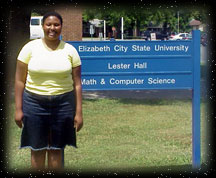
The ECSU Network Resources and Training Site provided partial support for research efforts of Dr. Banerjee and two of his research students to collaborate with Dr. Lawrence DeLucas.


Dr.
Lawrence J. Delucas
Biography
Lawrence J. DeLucas (b. 1950), Professor of Optometry, Director of the Center for Macromolecular Crystallography and Senior Scientist in the VSRC. He received a B.S. (1972) from The University of Alabama at Birmingham. After a two-year period as a research assistant in the UAB Institute of Dental Research, he started graduate school and received a M.S. (1973) in chemistry. During 1975-1976, he worked as a research associate in the Department of Biochemistry with Dr. Charles E. Bugg on the crystallographic analysis of small molecules considered to be of biological importance. In the fall of 1976, Dr. DeLucas began two degree programs at UAB. He was awarded an O.D. (1981) and he completed the requirements for a Ph.D. (1982) in biochemistry.
Abstract Report
Objective:
Identify peptide sequences that specifically bind to Human Spermatozoa.
To use cyclic peptide phage library to screen human spermatozoa. The phage library will permit specific binding of spermatozoa. The goal of the research is to carry out four rounds of panning, which will consist of Swim up Sperm Preparation, Blocking with BSA, Amplification, and Titration of phage.
Swim up Preparation will be used in isolating the best human spermatozoa from debris and other cells. Blocking should reduce non-specific attachment and assist in specific binding of phage to spermatozoa. Amplification of phage allows a higher percentage of phage binding. Titration gives an actual count of phage that has bound to the human sperm. If the procedure is carried out correctly, our expectations will be that in each round of panning the percentage of phage bound will be higher. If sequences correspond to those of previous screening with linear peptide library research then the goal has been achieved.
Shaleka
Eley
6-21-01

Crystallization: The Final Report
In the continuation of my crystallization report, the results were the same as the last report. As I stated earlier in the previous report, the transformation procedure was a procedure that I had performed many of times for weeks. The results that I had were more negative than positive while doing transformation. Dr. Sha and I spent three to four weeks trying to figure out what was going on with the transformation process. Later I figured out the problem was the competent cells that I had prepared and was using, were considered to be contaminated. I prepared more competent cells and went on with my project. I continued the transformation process for about two weeks and kept on getting the same results: Results were as followed: I used the competent cells of DH5. Two 1.5ml tubes of 200ml of DHSL + 1+2(insert) and 200ml of DH5 + 28B(pcr product).

Then I placed 100 ml of DH5(Ligased/1+2) and DH5(Controlled/28B) on a kanimized antibiotic petri dish. I let the petri dish incubate for set at 37 C for twenty-four hours. The petri dishes were labeled as 28B Controlled and 1+2 Ligased. The plate labeled as 28B was suppose to be clear, but it had bacteria on it, so that was one of my problems. The plate labeled, as 1+2 was fine, bacteria were suppose to be on it. I performed this procedure for about two or three weeks, and kept getting the same results. There was only a few times I got positives results from the two petri dishes. After I got positive results I picked out four colonies, (bacteria) from each of the petri dishes, and let them grow in 3ml of LB medium added with 10 ml of kanimizing solution, in a 50 ml tube. I let the 50ml tubes shake in the shaker for four to six hours. Next, I performed another mini prep, which is used to amplify plasmid: this procedure goes as followed: First, Streak a plate using the shock which carries the plasmid u want to amplify: Pick up a colony and incubate it into 5ml LB medium with the right antibiotic: grow the E-Coli in the incubator at 37 C until it reaches OD O.6. Again I performed this procedure many of times, and kept getting the same results, so therefore I did not get to form a crystal. My professor Dr. Ben Sha told me that my outcome was normal; he said that it takes a while to form crystals. It normally takes about six months. He said the one of the main steps in crystallization is having to perform experiences over and over until you get positives results, and then you go from there. In the two months that I work with Dr. Sha, he taught me well and I enjoyed working with him. I hope I get the opportunity to work with Dr. Sha again.
Jordan Williams
July 24 2001


